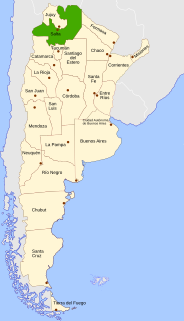
Santiago del Estero, also known simply as Santiago, is a province in the north of Argentina. Neighbouring provinces, clockwise from the north, are Salta, Chaco, Santa Fe, Córdoba, Catamarca and Tucumán.

The Bermejo River is a river in South America that flows from Bolivia to the Paraguay River in Argentina. The river is generally called Bermejo in spite of its different names along its way, but it also has its own Native American names; in Wichí it is called Teuco, and in Guaraní it is called Ypitá. In the plains of Argentina's Gran Chaco the Bermejo forms wetlands and splits into two branches. The southern branch is the bed of the old Bermejo River, now an intermittent stream called Río Bermejito. The northern branch is now the main stem of the Bermejo and is called the Teuco River, Bermejo Nuevo, or simply the Bermejo River. The two branches rejoin at 25°39′S60°11′W, near Villa Río Bermejito, forming the Lower Bermejo River.

The Dulce River is the most important river in the Argentine province of Santiago del Estero.

The Salado River is a river that crosses several provinces of Argentina, flowing 1,150 kilometres (710 mi) from its source in the Salta Province to end in the Paraná River, in the Santa Fe Province. Because its origin, its flow varies widely within the year, and it can dry out in some parts of its path during the winter. The only important tributary to the river is the Horcones River, which is born in Salta as Cajón River, and joins the Salado in the Santiago del Estero Province.
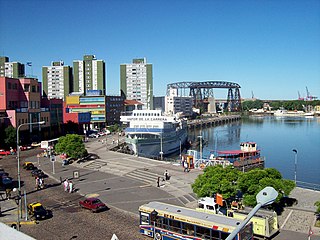
The Matanza River is known by several names, including, in Spanish, Río de la Matanza, Río Matanza, Río Mataderos, Río de la Manzana or simply Riachuelo. It is a 64-kilometre (40 mi) stream in Argentina that originates in the Buenos Aires Province and defines the southern boundary of the Buenos Aires federal district. It empties into the Río de la Plata between Tandanor and Dock Sud. The La Boca neighbourhood and the Boca Juniors football club are located near the Riachuelo's mouth. The Spanish word boca means "mouth".

Timoteo "Dino" Saluzzi is an Argentinian bandoneon player. He is the son of Cayetano Saluzzi and the father of guitarist José Maria Saluzzi.
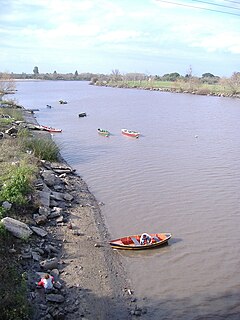
The Gualeguaychú River is a river in the province of Entre Ríos, Argentina. It starts in the center-east of the province, within the Colón Department, and flows south, passing by the city of Gualeguaychú and then emptying into the Uruguay River. Its drainage basin has an area of 6,693 square kilometres (2,584 sq mi).
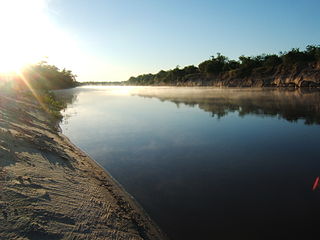
The Gualeguay River is one of the major rivers of the Mesopotamic province of Entre Ríos, Argentina. Its source is in the north of the province, in the region between the cities of Federación and San José de Feliciano, and meanders in a general south-southwestward direction across the center of the province for about 350 to 375 kilometres, receiving a large number of tributary streams. It passes by the cities of Villaguay, Rosario del Tala, and Gualeguay, and finally empties into the Río Paraná Ibicuy, a distributary of the Paraná River in the Paraná Delta.
The Guayquiraró River is a river in the Mesopotamic northeastern region of Argentina. It is born in the middle section of the border between the provinces of Entre Ríos and Corrientes, fed from several streams on its right-hand basin. It flows west along the interprovincial border for about 110 kilometres (68 mi), then emptying into the Paraná River, at a base level of about 26 metres (85 ft) AMSL.
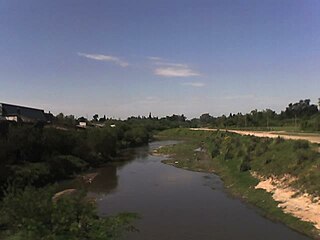
The Reconquista River is a small river in the province of Buenos Aires, Argentina. Together with the Riachuelo, it is one of the most contaminated watercourses in the country.

The Argentine motorcycle Grand Prix is the Argentine round of the FIM Grand Prix motorcycle racing championship. The Grand Prix returned in 2014 with a race at Autódromo Termas de Río Hondo. Previously, the event was held ten times at the Autódromo Oscar Alfredo Gálvez in the capital city of Buenos Aires between 1961 and 1999.

Iruya is a small town of population 1,070 in northwestern Argentina. It is located in the Salta Province of northwestern Argentina, and is the capital of the Iruya Department.
The Arenales River is a river of Argentina. A tributary of the Salado River, the Arenales flows through the city of Salta.

Aguas Blancas (Salta) is a village and rural municipality in Salta Province in northwestern Argentina. It is a city in the Oran department, located northeast of the province of Salta, Argentina. Aguas Blancas is located on the banks of the Bermejo River, which forms a natural boundary between Argentina and Bolivia.
Río Piedras is a village and rural municipality in Salta Province in northwestern Argentina.
Río del Valle is a village and rural municipality in Salta Province in northwestern Argentina.

Iruya is a department is located in the north of Salta Province in northwest Argentina in the high altitude basin of the Bermejo River. It is one of 23 administrative units in the province.


